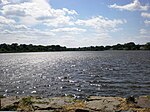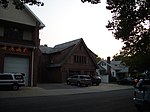Holy Trinity Episcopal Church (Spring Lake, New Jersey)
19th-century Episcopal church buildingsChurches completed in 1880Churches in Monmouth County, New JerseyChurches on the National Register of Historic Places in New JerseyEpiscopal church buildings in New Jersey ... and 7 more
Gothic Revival church buildings in New JerseyNational Register of Historic Places in Monmouth County, New JerseyNew Jersey Register of Historic PlacesNew Jersey Registered Historic Place stubsNew Jersey church stubsSpring Lake, New JerseyUse mdy dates from August 2023

Holy Trinity Episcopal Church is a historic church at the junction of Monmouth and Third Avenues in Spring Lake, Monmouth County, New Jersey, United States. It was built in 1880 and added to the National Register of Historic Places in 1991. The church houses a fully functional 1904 Bates & Culley pipe organ.
Excerpt from the Wikipedia article Holy Trinity Episcopal Church (Spring Lake, New Jersey) (License: CC BY-SA 3.0, Authors, Images).Holy Trinity Episcopal Church (Spring Lake, New Jersey)
Monmouth Avenue,
Geographical coordinates (GPS) Address Nearby Places Show on map
Geographical coordinates (GPS)
| Latitude | Longitude |
|---|---|
| N 40.146111111111 ° | E -74.031111111111 ° |
Address
Monmouth Avenue 341
07762
New Jersey, United States
Open on Google Maps








